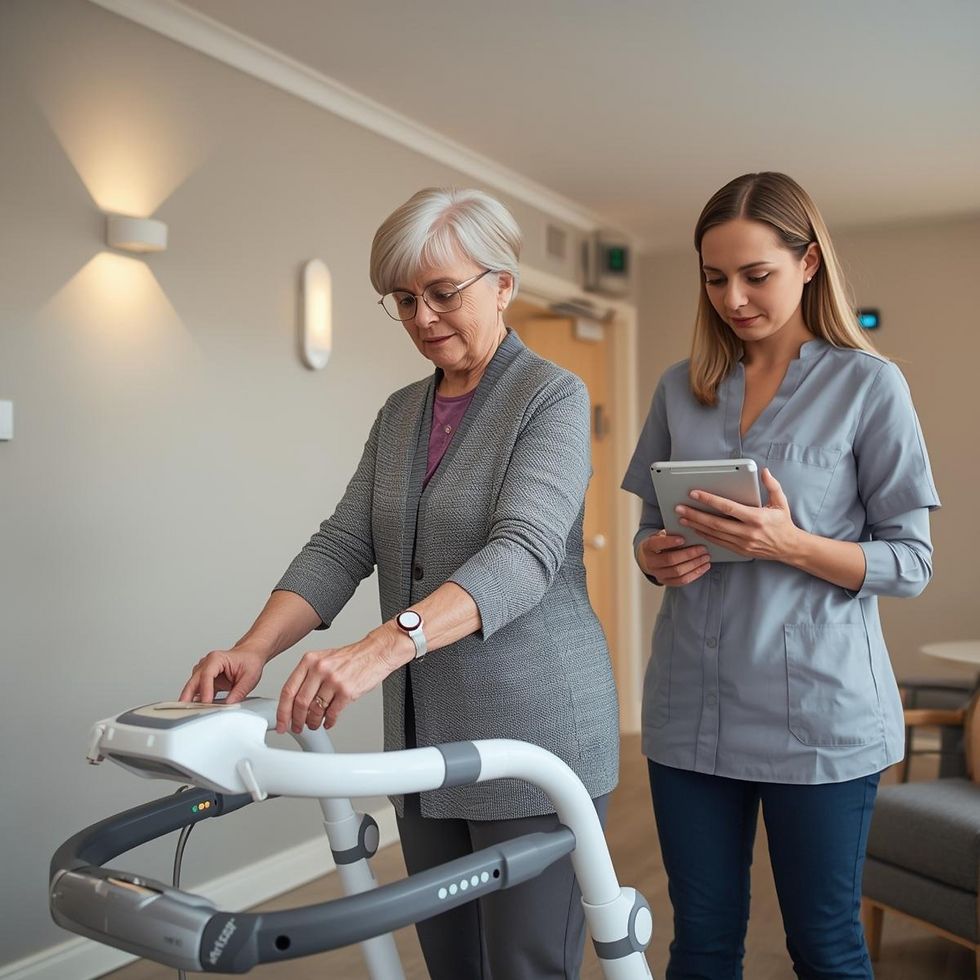Innovative Tools and Techniques Physical Therapists Use for Effective Fall Recovery
- The ResQUp

- 4 days ago
- 3 min read
Falls are a major concern in rehabilitation centers, especially for older adults and individuals recovering from injuries. Physical therapists play a crucial role in helping patients regain strength, balance, and confidence after a fall. Their approach combines hands-on therapy with specialized tools and devices designed to support recovery and prevent future falls. This post explores how physical therapists solve fall recovery challenges, highlighting the tools they use and devices like the ResQUp that assist patients in safely getting up after a fall.

Understanding Fall Recovery in Rehab Centers
Fall recovery is a complex process that involves more than just healing injuries. Physical therapists assess each patient’s unique needs, including muscle strength, joint mobility, balance, and coordination. They design personalized rehabilitation plans that focus on restoring function and reducing the risk of future falls.
The recovery process often starts with gentle exercises to improve flexibility and strength. Therapists gradually introduce balance training and functional activities that mimic daily movements. This step-by-step approach helps patients rebuild confidence and independence.
Tools Physical Therapists Use for Fall Recovery
Physical therapists rely on a variety of tools to support patients during fall recovery. These tools help improve strength, balance, and coordination while providing safety and motivation.
Balance Boards and Stability Trainers
These devices challenge patients to maintain their balance on unstable surfaces. Using balance boards helps strengthen core muscles and improve proprioception, which is the body’s ability to sense its position in space.
Resistance Bands and Weights
Resistance bands provide adjustable levels of resistance for muscle strengthening exercises. Weights, such as ankle or wrist weights, add intensity to workouts, helping patients regain muscle mass lost due to inactivity.
Gait Trainers and Parallel Bars
Gait trainers assist patients in relearning how to walk safely. Parallel bars provide support and stability during walking exercises, allowing therapists to monitor and correct posture and movement.
Treadmills with Body Weight Support Systems
These treadmills reduce the load on joints and muscles, enabling patients to practice walking with less risk of falling. The body weight support system helps patients regain walking ability in a controlled environment.
Devices That Help Patients Get Up After a Fall
One of the biggest challenges after a fall is safely getting back up without causing further injury. Physical therapists often introduce assistive devices that empower patients to rise independently or with minimal help.
The ResQUp Device
The ResQUp is a practical tool designed to help individuals get up from the floor after a fall. It is a compact, portable device that provides leverage and support, making it easier to get up to a seated position or stand up without straining muscles or joints.
How It Works
The ResQUp serves as a sturdy handle for users to grip and push themselves up. It positions securely to the floor, providing a stable surface for users to lift their body weight.
Benefits in Rehab Settings
Physical therapists incorporate the ResQUp into therapy sessions to teach patients safe techniques for getting up after a fall. This device boosts confidence and reduces the fear of falling again.
Patient Independence
By practicing with the ResQUp, patients learn to manage falls independently, which can reduce emergency calls and hospital visits.
Other Assistive Devices
Grab Bars and Handrails
Installed in patient rooms and bathrooms, these provide steady support for standing and moving.
Lift Assist Devices
Mechanical lifts or transfer aids help therapists safely move patients who cannot stand independently.
Techniques Physical Therapists Use Alongside Tools and Devices
Physical therapists combine tools and devices with proven techniques to maximize recovery outcomes.
Task-Specific Training
Therapists simulate real-life scenarios, such as getting up from the floor or climbing stairs, to improve functional ability.
Strength and Balance Exercises
Exercises focus on lower body strength, core stability, and balance to reduce fall risk.
Education and Fall Prevention Strategies
Patients learn about safe movement, home modifications, and how to use assistive devices properly.
Motivational Coaching
Therapists encourage patients to stay active and engaged, which is vital for long-term recovery.
Measuring Progress and Adjusting Therapy
Physical therapists continuously monitor patients’ progress using objective measures like balance tests, walking speed, and strength assessments. They adjust therapy plans based on improvements or challenges, ensuring that each patient receives the right level of support.
Final Thoughts on Fall Recovery in Rehab Centers
Physical therapists use a combination of specialized tools, assistive devices like the ResQUp, and targeted techniques to help patients recover from falls effectively. These approaches not only restore physical function but also build confidence and independence. For anyone facing fall recovery, working closely with a skilled therapist and using the right tools can make a significant difference in regaining mobility and preventing future falls.




Comments